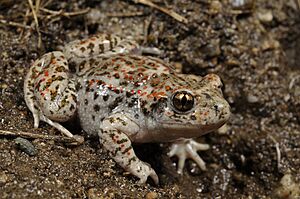Iberian midwife toad facts for kids
Quick facts for kids Iberian midwife toad |
|
|---|---|
 |
|
| Conservation status | |
| Scientific classification | |
 |
|
| Synonyms | |
|
Ammoryctis cisternasii — Lataste, 1879 |
The Iberian midwife toad (Alytes cisternasii) is a special type of frog. It is also called the brown midwife toad. In Portugal, people call it sapo-parteiro-ibérico. This toad lives in Portugal and the western parts of Spain.
It likes to live in open areas. These include grassy fields and open oak forests. Sadly, losing its home is a big problem for this toad.
Contents
What Does the Iberian Midwife Toad Look Like?
The Iberian midwife toad is not very big. It usually grows to about 40 millimeters (about 1.5 inches) long. Male toads are a bit smaller than females.
Its nose is round, and its eyes are large. The pupils in its eyes are like thin, vertical lines. You might see tiny, often orange, bumps on its eyelids.
Skin and Color
This toad has many small bumps, called tubercles, on its body. It also has groups of special bumps under its arms, near its legs, and on its ankles. Its legs are quite short.
The top of the toad is brownish-grey with dark spots. The bumps on its skin are often reddish. Its belly is plain and greyish-white.
Where Does the Iberian Midwife Toad Live?
This toad is native to Portugal and western Spain. It lives in areas up to 1,300 meters (about 4,265 feet) above sea level.
It prefers places with Mediterranean-style bushes and plants. It also likes rough grazing lands and light oak woodlands.
The Iberian Midwife Toad's Life Cycle
Mating for these toads happens in the autumn. The female toad lays her eggs on land. Then, the male toad does something very unique!
He gathers the eggs and wraps them around his legs. He carries these eggs with him until the baby toads inside are ready to hatch. A male toad can carry as many as 180 eggs at once! These eggs can even come from different females.
When the tiny tadpoles are ready, the male takes them to a suitable water body. There, the tadpoles continue to grow. They change into young toads about four months later. At this time, the tadpoles are about 70 millimeters (about 2.7 inches) long.
Challenges the Iberian Midwife Toad Faces
The Iberian midwife toad faces several threats. One big problem is that its natural home is being damaged. Pollution also hurts them.
Another issue is the loss of good pools for breeding. Also, new animals are being introduced that are not native to the area. These include the invasive crayfish Procambarus clarkii and non-native fish. Both of these animals like to eat the toad's tadpoles.
The toad is also threatened by a serious fungal disease. This disease is called chytridiomycosis.


